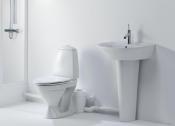Search
Login
Recommended
Which is better: mineral wool or polystyrene, we compare two types of thermal insulation materials. What material to choose, how to do it right
The most popular thermal insulation materials in today's construction are mineral wool and polystyrene foam. Both materials have excellent characteristics and are recommended for thermal insulation work. You can hear the opinion that these materials are interchangeable, although experts recommend the use of mineral wool in the construction of roofs and ventilated facades, and expanded polystyrene for external wall insulation. In order to choose the right material in a particular case, you should learn a little more about its positive qualities and shortcomings.
Content
- Expanded polystyrene, its advantages and weaknesses video video
- Mineral wool, what it is, its advantages and disadvantages video
- To summarize the comparison of materials - which is better: polystyrene foam or mineral wool?
- We take into account the scope
Polyfoam, its advantages and weaknesses
Polyfoam is considered to be the best of heat insulators, its 10-cm-thick slab can replace 4 m thick concrete, 1.5 m hollow brick masonry, 0.9 m expanded clay concrete, 0.6 m aerated concrete, and even 0.4 m of wood. It retains heat about one and a half times better than mineral wool.
The vapor permeability of polystyrene foam can have different indicators, depending on its density. Low-density material allows steam to pass through in much the same way as cotton wool; more dense material passes it with difficulty.

Sometimes you have to hear the opinion that the foam, when heated, emits styrene vapors harmful to humans into the environment. Modern research proves that such an opinion is erroneous, high-quality polystyrene is actually absolutely harmless, it releases toxic substances in extremely small quantities that are not harmful to humans.
Before buying the material, you can make sure that the residual styrene content is between 0.01 and 0.05%.
Expanded polystyrene is a material with a long service life. The most durable, pressure-free foam grades have a service life of 10 to 40 years, extruded - up to 80.
Among the negative qualities of the material, one can note its selective ability to noise isolation and a tendency to flammability. The acoustic characteristics of a material depend on its structure, i.e. depending on the type of porosity: materials with closed porosity, such as expanded polystyrene, extruded polyethylene, polyvinyl chloride foam, have the ability to absorb sounds whose frequency exceeds 1600 hertz, i.e. they will eliminate the fan noise efficiently enough, but at the same time they will absolutely not affect the audibility, for example, of a person’s steps. Foams with open porosity, such as polyurethane foam, perfectly absorb noise of any frequency, so they can be used as a soundproofing material.

As for fire safety, the foam emits smoke that is toxic to humans when burning. However, modern species, the basis of which is polystyrene foam, contain in their composition substances that not only prevent the possibility of fire, but also contribute to the extinction of the flame. SPB-S self-extinguishing polystyrene belongs to the new generation; it is impossible to ignite it from a spark, but it is still not protected from the harmful effects of a fire.
Some problems can cause a very low, but still existing ability of the material to absorb water. The ingestion of very small pores present inside an insignificant amount of liquid during the freezing process can lead to destruction of the internal structure of the foam. Moreover, press and non-foam polystyrene are subject to such destructive effects of moisture.
The use of polystyrene boards is recommended only for the installation of external thermal insulation.
Arguing which foam is best, first of all, it is necessary to carefully examine its qualitative characteristics and their compliance with the most important requirements that apply to a heat-insulating material in each specific case: thermal conductivity and noise absorption, hygroscopicity, and fire resistance.
Mineral wool, what it is, its advantages and disadvantages
Mineral wool, which is actively used in construction, is of two types, they are due to the raw materials used in production:
glass wool is made from glass battle or quartz sand, by melting and blowing raw materials into thin fibers, the color of glass wool is light yellow
basalt wool is produced by melting rocks, its color can be from brown-yellow to greenish.

It is unambiguous to say which mineral wool is better difficult, the characteristics of both types of material are almost identical, however, the basalt variety has a higher fire resistance coefficient, and glass wool has a lower specific gravity.
Both types of cotton wool owe all their positive qualities to the properties of igneous rocks or quartz sand. Minvata is a non-combustible material, its melting point is about +800 degrees C. At lower temperatures, it does not change its properties, it does not contribute to the spread of fire.
It has a high rate of thermal insulation, the second after expanded polystyrene. But moistening of the material can have a significant effect on its reduction, the reason for this is the high hygroscopicity of mineral wool. At the same time, the material is capable of perfectly passing steam through its fibrous structure. The advantages of mineral wool include its excellent ability to absorb sound.

But this seemingly perfect material is also not without flaws. The first of them is a lot of weight, which contributes to the weighting of building structures and creates certain problems when delivered to a construction site.
The environmental friendliness of the material is also somewhat problematic: the binder used in the manufacture of cotton wool can release a highly toxic component - formaldehyde, and its fibers themselves contain carcinogens. Due to these factors, the use of mineral wool is allowed only when installing external thermal insulation.
To summarize the comparison of materials - which is better: polystyrene foam or mineral wool?

For greater clarity, we compare both types of heat-insulating materials by their quality characteristics:
- in terms of thermal insulation characteristics, polystyrene confidently leads, even in relation to mineral wool,
- mineral wool has a higher permeability
- the hygroscopicity of the foam is lower, subject to installation technologies, it can be operated without problems in humid conditions, this cannot be said about mineral wool
- the cost of polystyrene foam is lower than other thermal insulation materials
- the low weight of the foam simplifies its delivery and facilitates installation, the foam is easier to handle, difficulties can arise only when processing the joints of the foam plates
- both materials are not suitable for internal work
- chemical resistance: minvat, unlike polystyrene, is not affected by organic solvents
- both materials do not promote the growth of bacteria or fungi on their surface.

We take into account the scope
From the foregoing, we can conclude that determining which is better: polystyrene or glass wool is quite difficult. Therefore, when choosing a material, another very significant point should be taken into account: exactly where they will be used.
When constructing ventilated facades, it will be more rational to use mineral wool, if the wall structure provides for plastering the surface after warming, then the use of polystyrene foam is the best option, the same material can be chosen for the construction of walls with a three-layer structure.

Mineral wool and polystyrene can be used in the assembly of various communication structures in modern buildings: ventilation, plumbing and drainage, sewer. In this case, the possible influence of high temperatures, the possibility of the appearance of an aggressive chemical environment around the object are taken into account. In the high-risk zone, mineral wool should be preferred, which has higher resistance to aggressive factors and high temperatures.






